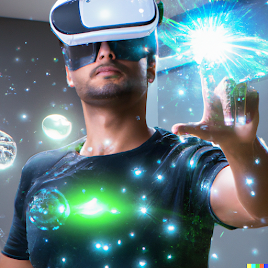Virtual and Augmented Reality
Introduction to Virtual and Augmented Reality
Virtual and augmented reality (VR/AR) are technologies that allow users to experience the world in a completely different way. Using headsets, motion tracking, and other tools, users can interact with digital environments and objects in a way that feels real.
VR and AR are being used in a variety of applications, from gaming to medical training, and they have the potential to revolutionize the way we interact with digital content. The possibilities are endless, and the technology is only getting better.
VR and AR are being used in a variety of applications, from gaming to medical training, and they have the potential to revolutionize the way we interact with digital content. The possibilities are endless, and the technology is only getting better.
Benefits of Virtual and Augmented Reality
VR and AR offer a variety of benefits to users. By immersing people in a digital environment, they can experience a level of realism that is not possible with other forms of media. This can help people learn, explore, and create in ways that would otherwise be impossible.
VR and AR also have the potential to revolutionize the way we interact with digital content. By allowing users to interact with digital objects and environments in a more natural way, they can become more engaged and have a more meaningful experience
VR and AR also have the potential to revolutionize the way we interact with digital content. By allowing users to interact with digital objects and environments in a more natural way, they can become more engaged and have a more meaningful experience
Applications of Virtual and Augmented Reality
VR and AR are being used for a variety of applications, from gaming to medical training. In gaming, VR and AR can create immersive and interactive experiences that are more engaging than traditional video games. In medical training, VR and AR can be used to simulate real-world scenarios and allow students to practice in a safe environment.
VR and AR are also being used in a variety of other industries, such as architecture, engineering, manufacturing, and retail. The possibilities are endless, and the technology is only getting better.
VR and AR are also being used in a variety of other industries, such as architecture, engineering, manufacturing, and retail. The possibilities are endless, and the technology is only getting better.
Future of Virtual and Augmented Reality
VR and AR are still relatively new technologies, and they have a lot of potential for growth. As the technology improves, it will become more accessible and more widely used. We will also see more applications for VR and AR, from entertainment to education.
The future of VR and AR is bright, and the possibilities are endless. As the technology improves and becomes more widely used, we will see more and more applications for these technologies, and they will revolutionize the way we interact with digital content.
The future of VR and AR is bright, and the possibilities are endless. As the technology improves and becomes more widely used, we will see more and more applications for these technologies, and they will revolutionize the way we interact with digital content.
Limitations of Virtual and Augmented Reality
While VR and AR offer a lot of potential, they also have their limitations. The technology is still relatively new and can be expensive, making it inaccessible to some people. Additionally, the technology is still being developed, and it can be difficult to create realistic and immersive experiences.
VR and AR also have potential health risks, such as motion sickness and eye strain. It is important to be aware of these risks and take steps to minimize them when using the technology.
VR and AR also have potential health risks, such as motion sickness and eye strain. It is important to be aware of these risks and take steps to minimize them when using the technology.
Conclusion
Virtual and augmented reality offer a lot of potential for the future. They have the potential to revolutionize the way we interact with digital content and create immersive and engaging experiences. However, it is important to be aware of the potential risks and limitations of the technology.
VR and AR are still relatively new, and the technology is only getting better. As the technology improves and becomes more widely used, we will see more and more applications for these technologies, and they will continue to revolutionize the way we interact with digital content.






